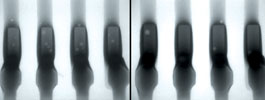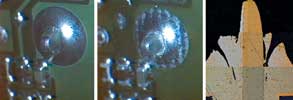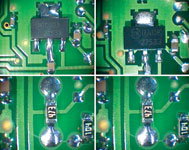
At Loewe, the manufacturer of TVs and multimedia devices in Upper Franconia, Germany, serial production started a short time ago with lead-free solder paste on a production line.
The aim of the examinations that preceded this, was to find out whether there are considerable differences between Pb-containing and Pb-free solder alloys, regarding the technology and also in the properties of the solder joints.
Tests
Tests were done at the heart of a television - the signal board. The solder pastes F 381 (with lead) and F 640 (lead-free) manufactured by Heraeus were used for the comparison tests. The lead-free solder paste contains synthetic resins that are suitable for the higher solder temperature, and that show excellent solder results on all pad surfaces when soldered under either air or nitrogen.
Due to the type of components used, televisions require mixed technology: soldering is performed without lead. However, on the signal board, besides the lead-free pastes, there are components with a tin lead finish that do not allow the production of completely lead-free parts despite the application of lead-free pastes. At present, a signal board has a lead content of about 1%. Using PCBs with OSP pads, the reflow process and the wave soldering are performed under nitrogen. The examinations comprised, in addition to the properties regarding the auxiliary materials and components, also the process parameters. A production failure rate of less than 10 ppm was the aim for the test results. This rate is an economic target value.
Findings
In November 2003, Loewe supplied lead-free soldered signal boards for the first time. No failures are known so far. Loewe has supplied the lead-free soldered remote control (the RC2) since July 2003. Here also, there have been no warranted repairs of solder joints. In Kronach, Germany, at the Landesgartenschau horticultural show, there are 15 lead-free TV sets and 15 that contain lead, that have been running for 3600 hours in the Plessi tower. Only the lead-free televisions have shown no failures at the solder joints. At the Plessi tower a video performance runs there daily, from dawn, on 30 TV sets. In this life test, the lead-free televisions with 15 000 hours of operation have demonstrated considerably fewer solder joint failures than the comparable devices that contain lead.
The life test is performed as follows: The televisions are in operation for 20 hours per day at 40°C. They are switched off for 3 hours, cooled down to 10°C, and they are permanently switched on and switched off for 2 hours.
No modifications of the machines were required for the reflow process.
Test results
Screen printing was performed in a DEK screen printing machine, onto FR4 boards coated with OSP, with a 150 μm stencil, and 2-dimensional inspection in an open squeegee system.
The pictures in Figure 1 show the lead-containing solder paste F 381 versus F 640 which is lead-free, both produced by Heraeus. There is only a minor difference between the pastes in their printing performance.

Figure 2 shows die assembly of components 0603 to QFP 160 with Panasonic pick-and-place machines. The process is virtually the same. Low pressure should be applied while inserting the component in the paste.

Figure 3 shows reflow soldering results in a Rehm convection oven, under nitrogen. 1000 ppm is sufficient for a good solder result. Here the lead-free solder joints are slightly duller. The lead-free paste has almost the same wetting performance as the paste with lead. In the reflow process, the maximum peak temperature is about 235°C.

The automatic optical inspection (AOI) of the solder joints is made with a Viscom test control unit (Figure 4). This AOI needs to be optimised for lead-free solder joints, as the solder joints reflect light differently. Thereafter, the results look similar. There are practically no other solder failures.
After switching to lead-free, the first pass yield values increased by 1,26%, from 96,79% to 98,05% in automatic placement.

Wave soldering process
The manual pick-and-place is followed by the lead-free wave soldering process, under nitrogen, in an ERSA-N-Wave machine, with alcohol-based solder flux, at 260°C. The wave soldering machine had to be adapted to the lead-free process, as lead-free solder etches the standard V2A material. The real failure rate in shorts is about 40 ppm, referring to the solder joints, for both solders. There rarely are open solder joints, less than 4 ppm.

The Thermal Cycling tests showed better results with the lead-free solder joints, compared to those containing lead.

Automatic optical inspection
With the same real failure rate, the AOI (automatic optical inspection) with a Modus test control unit features a considerably better process reliability, because of the duller solder joints. This machine compares pictures, and there are less disturbing, bright reflections in the picture. The cpk value increases from c. 1,4 to 1,9.

The 'in-circuit tests' and 'functional tests' showed no deterioration when lead-free solders are used.
Conclusion
In the field, there were considerably fewer failures. This confirms the results that were obtained during the life test. Thus, switching to lead-free solder joints is not only a step to improve the environment, but it also contributes to a higher customer satisfaction at Loewe.
| Tel: | +27 11 726 6758 |
| Email: | [email protected] |
| www: | www.eispty.co.za |
| Articles: | More information and articles about Electronic Industry Supplies |
© Technews Publishing (Pty) Ltd | All Rights Reserved